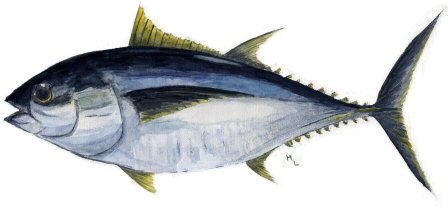
Thunnus obesus
Bigeyed Tuna, Bigeyed Tunny
The Bigeye Tuna is very similar in looks to the Yellowfin Tuna, even down to the yellow inlets edged in black. However their anal fin and second dorsal fin will never reach nearly the same length as that of a Yellowfin. The gold stripe common to the Yellowfin is usually absent, but may be dimly present. The eye is indeed larger, but this might not be readily apparent without a side-by-side comparison. A scientist might have to examine the liver to be perfectly sure of identification with some specimens, but anglers seldom have to worry, simply because the Bigeye is a rare catch, whereas the Yellowfin is common in many areas.
Bigeye Tuna will follow mullet, herring, mackerel, flying fish, whiting, and other schooling baitfish. They will also feed on squid, eels, and crustaceans.
It is uncommon but present off all Florida coasts, the Bahamas and the Caribbean.
Like the other tuna, this is a highly migratory fish. As the name bigeye suggests, these schooling fish spend most of their time deep beneath the ocean's surface. During daylight hours, they will stay at depths of roughly 100 feet.
Bigeye commonly grow to 100 pounds and can reach up to 300 pounds.
435 pounds, 0 ounces (IGFA)